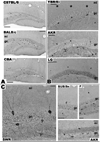Nicotinic acetylcholine receptor expression in the hippocampus of 27 mouse strains reveals novel inhibitory circuitry
- PMID: 18446824
- PMCID: PMC2792088
- DOI: 10.1002/hipo.20430
Nicotinic acetylcholine receptor expression in the hippocampus of 27 mouse strains reveals novel inhibitory circuitry
Abstract
Mouse strains are well-characterized to exhibit differences in their physiological and behavioral responses to nicotine. This report examines the expression of the high-affinity nicotine binding receptor subunit, neuronal nicotinic receptor subunit alpha 4 (nAChR alpha 4), in the dorsal hippocampus of 27 inbred mouse strains. Multiple differences among mouse strains in the cellular expression of nAChR alpha 4 between subregions of the hippocampal field are evident. Differences that we describe in the expression of nAChR alpha 4 suggest mouse strains of diverse genetic origin could exhibit significant variation in how this receptor contributes to modulating intrahippocampal circuitry. These findings define a genetic frame-work in which the strain-specific responses to nicotine include underlying contributions by the varied anatomical context in which nAChRs are expressed.
(c) 2008 Wiley-Liss, Inc.
Figures







Similar articles
-
Mouse chromosome 11 harbors genetic determinants of hippocampal strain-specific nicotinic receptor expression.Hippocampus. 2008;18(8):750-7. doi: 10.1002/hipo.20454. Hippocampus. 2008. PMID: 18528848 Free PMC article.
-
Mouse strain-specific nicotinic acetylcholine receptor expression by inhibitory interneurons and astrocytes in the dorsal hippocampus.J Comp Neurol. 2004 Jan 12;468(3):334-46. doi: 10.1002/cne.10943. J Comp Neurol. 2004. PMID: 14681929
-
Differential signalling induced by α7 nicotinic acetylcholine receptors in hippocampal dentate gyrus in vitro and in vivo.J Physiol. 2021 Oct;599(20):4687-4704. doi: 10.1113/JP280505. Epub 2021 Sep 28. J Physiol. 2021. PMID: 34487349 Free PMC article.
-
The nicotinic acetylcholine receptor subtypes and their function in the hippocampus and cerebral cortex.Prog Brain Res. 2004;145:109-20. doi: 10.1016/S0079-6123(03)45007-3. Prog Brain Res. 2004. PMID: 14650910 Review.
-
Nicotinic receptors and hippocampal synaptic plasticity ... it's all in the timing.Trends Neurosci. 2002 Apr;25(4):171-2. doi: 10.1016/s0166-2236(00)02127-5. Trends Neurosci. 2002. PMID: 11998680 Review.
Cited by
-
Nicotinic excitatory postsynaptic potentials in hippocampal CA1 interneurons are predominantly mediated by nicotinic receptors that contain α4 and β2 subunits.Neuropharmacology. 2011 Dec;61(8):1379-88. doi: 10.1016/j.neuropharm.2011.08.024. Epub 2011 Aug 25. Neuropharmacology. 2011. PMID: 21878344 Free PMC article.
-
Insights Into Nicotinic Receptor Signaling in Nicotine Addiction: Implications for Prevention and Treatment.Curr Neuropharmacol. 2018;16(4):350-370. doi: 10.2174/1570159X15666170801103009. Curr Neuropharmacol. 2018. PMID: 28762314 Free PMC article. Review.
-
Mouse chromosome 11 harbors genetic determinants of hippocampal strain-specific nicotinic receptor expression.Hippocampus. 2008;18(8):750-7. doi: 10.1002/hipo.20454. Hippocampus. 2008. PMID: 18528848 Free PMC article.
-
Mammalian nicotinic acetylcholine receptors: from structure to function.Physiol Rev. 2009 Jan;89(1):73-120. doi: 10.1152/physrev.00015.2008. Physiol Rev. 2009. PMID: 19126755 Free PMC article. Review.
-
The Cholinergic System Modulates Memory and Hippocampal Plasticity via Its Interactions with Non-Neuronal Cells.Front Immunol. 2017 Nov 8;8:1489. doi: 10.3389/fimmu.2017.01489. eCollection 2017. Front Immunol. 2017. PMID: 29167670 Free PMC article. Review.
References
-
- Adams CE, Stitzel JA, Collins AC, Freedman R. Alpha7-nicotinic receptor expression and the anatomical organization of hippocampal interneurons. Brain Res. 2001 Feb;922:180–190. - PubMed
-
- Alkondon M, Albuquerque EX. A non-alpha7 nicotinic acetylcholine receptor modulates excitatory input to hippocampal CA1 interneurons. J Neurophysiol. 2002;87(3):1651–1654. - PubMed
-
- Alkondon M, Albuquerque EX. The nicotinic acetylcholine receptor subtypes and their function in the hippocampus and cerebral cortex. Prog Brain Res. 2004;145:109–120. - PubMed
-
- Altavista MC, Gozzo S, Iacopino C, Albanese A. A genetic study of neostriatal cholinergic neurones in C57BL/6 and DBA/2 mice. Funct Neurol. 1987;2(3):273–279. - PubMed
-
- Bovet D, Bovet-Nitti F, Oliverio A. Effects of nicotine on avoidance conditioning of inbred strains of mice. Psychopharmacologia. 1966;10(1):1–5. - PubMed
Publication types
MeSH terms
Substances
Grants and funding
LinkOut - more resources
Full Text Sources
Other Literature Sources

